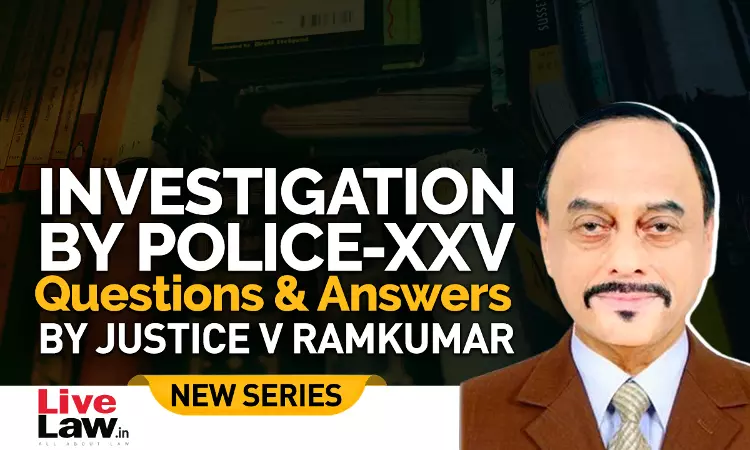- Home
- /
- Top Stories
- /
- Questions & Answers By Justice V....
Questions & Answers By Justice V. Ramkumar- Investigation By Police- PART XXV
Justice V. Ramkumar
28 Jan 2023 2:30 PM IST
Q.121 When does trial start in a “warrant case” and a “sessions case”?Ans.· The following are the provisions in the Cr.P.C. pertaining to the framing of charge in warrant and sessions trial:-Warrant - Sec. 240 (police charge case)- Sec. 246 (complaint case)Sessions - Sec. 228· In paragraph 28 of Ratilal Bhanji Mithani v. State of Maharashtra – (1979) 2 SCC 179 = AIR 1979 SC...
Q.121 When does trial start in a “warrant case” and a “sessions case”?
Ans.
· The following are the provisions in the Cr.P.C. pertaining to the framing of charge in warrant and sessions trial:-
Warrant - Sec. 240 (police charge case)
- Sec. 246 (complaint case)
Sessions - Sec. 228
· In paragraph 28 of Ratilal Bhanji Mithani v. State of Maharashtra – (1979) 2 SCC 179 = AIR 1979 SC 94 – 3 Judges – Sarkaria, Chinnappa Reddy & A.P. Sen, it was observed as follows:-
“The trial in a warrant case starts with the framing of charge; prior to it the proceedings are only an inquiry”.
Subsequently, in paragraph 39 of the 4 Judges Bench of the Supreme Court of India in V. C. Shukla v. State through CBI 1980 Supp. SCC 92 = AIR 1980 SC 962 – 4 Judges – S. Murtaza Fazl Ali, P. N. Shingal, D. A. Desai, A. P. Sen - JJ, without reference to Ratilal Bhanji Mithani observed as follows:-
“The proceedings starting with Section 238 of the Code including any discharge or framing of charge under Sections 239 or 240 amounts to a trial”.
· In Hardeep Singh v. State of Punjab (2014) 3 SCC 92 = AIR 2014 SC 1400 - 5 Judges – P. Sathasivam, Dr. B. S. Chauhan, Ranjana Prakash Desai, Ranjan Gogoi, S. A. Bobde – JJ, after referring to –
1. Raj Kishore Prasad v. State of Bihar (1996) 4 SCC 495 = AIR 1996 SC 1931 – Madan Mohan Punchhi, K. T. Thomas - JJ;
2. Ratilal Bhanji Mithani v. State of Maharashtra – (1979) 2 SCC 179 = AIR 1979 SC 94 – 3 Judges - Sarkaria, Chinnappa Reddy & A.P. Sen – JJ;
3. V.C.Shukla v. Union of India 1980 Supp. SCC 92 = AIR 1980 SC 962 - 4 Judges – S. Murtaza Fazl Ali, P. N. Shingal, D. A. Desai, A. P. Sen - JJ;
4. Union of India v. Madan Lal Yadav (1996) 4 SCC 127 – 3 Judges – K. Ramaswami, S. Saghir Ahmad, G. B. Pattanaik - JJ;
5. Common Cause, a Regd. Society v. Union of India (1996) 6 SCC 775 = AIR 1997 SC 1539 – B. P. Jeevan Reddy, S. B. Majumdar – JJ, etc.
concluded in paragraphs 35 and 43 (paras 38 and 47 of SCC) that trial commences with the framing of charge.
· After Ratilal Bhanji Mithani (AIR 1979 SC 94) - 3 Judges – Sarkaria, Chinnappa Reddy & A.P. Sen – JJ and V. C. Shukla (AIR 1980 SC 962) –4 Judges – S. Murtaza Fazl Ali, P. N. Shingal, D. A. Desai, A. P. Sen - JJ, and other verdicts referred to, the general understating among the legal fraternity is that the trial in a warrant or sessions case starts with the framing of charge. But this is really a mistaken impression since the subsequent part of the relevant passage in Ratilal Bhanji’s case has not been imbibed by many of the judicial verdicts. The entire passage reads as follows:-
“The trial in a warrant case starts with the framing of charge; prior to it the proceedings are only an inquiry. After the framing of charge if the accused pleads not guilty, the Magistrate is required to proceed with the trial in the manner provided in Section 254 to 258 to a logical end”.
· This is fortified by the words “claims to be tried” occurring in –
Sec. 242 (1) Cr.P.C – Warrant case on “police report”
Sec. 246 (4) Cr.P.C – Warrant case otherwise than on “police report”, and
Sec. 230 Cr.P.C – “Sessions trial”
· If trial starts with the framing of charge, then how can we explain the following situations –
1. The accused voluntarily pleads guilty to the charge framed against him and the Magistrate convicts him and passes a sentence against him. Is there a “trial” ? No.
2. During the preliminary hearing under Section 227 Cr.P.C. the Sessions Judge finds that the offence is not exclusively triable by a Court of Session. He, therefore, proceeds under Section 228 (1) (a) Cr.P.C. by framing the charge and transferring the case for trial to the Magistrate concerned. Has the trial started before the Sessions Judge with the framing of charge ? No.
(Of course, the word used here in Section 228 (1) (a) is “he may frame a charge”. It is not mandatory. Moreover, the Section does not say that after framing a charge the Sessions Judge should take the plea. The Magistrate also cannot take the plea of he accused on the charge framed by the Sessions Judge. Hence the Magistrate will have to frame charge afresh under Section 240 or 246, as the case may be. That apart, the wording of Section 228 (1) (a) is also that “frame a charge…….and transfer the case for trial”).
To sum up, a proper understanding of Ratilal Bhanji Mithani and the above provisions (Ss. 240, 246, 228) would indicate that after framing charge, it is only when the accused pleads not guilty and claims to be tried, that the trial can legitimately start.
In paragraph 28 of Ratilal Bhaji v. State of Maharashtra – (1979) 2 SCC 179 = AIR 1979 SC 94 – 3 Judges – R. S. Sarkaria, O. Chinnappa Reddy, A. P. Sen - JJ, it was observed as follows:-
“The trial in a warrant case starts with the framing of charge; prior to it the proceedings are only an inquiry. After the framing of charge if the accused pleased not guilty, the Magistrate is required to proceed with the trial in the manner provided in section 254 to 258 to a logical end”.
Subsequently, in paragraph 39 of the 4 Judges Bench of the Supreme Court of India in V. C. Shukla v. State through CBI 1980 Supp. SCC 92 = AIR 1980 SC 962 - S. Murtaza Fazl Ali, P. N. Shinghal, D. A. Desai, A. P. Sen - JJ, without reference to Ratilal Bhanji observed as follows:-
“The proceedings starting with Section 238 of the Code including any discharge or framing of charge under Sections 239 or 240 amounts to a trial”
The following are the provisions in the Cr.P.C. pertaining to the framing of charge in warrant and sessions trial:-
Warrant - Sec. 240 (police charge case)
- Sec. 246 (complaint case)
Sessions - Sec. 228
After Ratilal Bhanji and V. C. Shukla, the general understating among the legal fraternity is that the trial in a warrant or sessions case starts with the framing of charge. But this is really a mistaken impression in view of the words “claims to be tried” occurring in –
Sec 242 (1) Cr.P.C. – Warrant case on “police report”.
246 (4) Cr.P.C. – Warrant case otherwise than on “police report”, and
Sec 230 Cr.P.C. – In the case of “Sessions trial”
The above provisions would indicate that after framing charge, it is only when the accused pleads not guilty and claims to be tried, can the trial legitimately start. This is the real purport of Ratilal Bhanji (Supra). But, there are decisions both of the Supreme Court and of various High Courts to the effect that the trial starts with the framing of charge. Such a view has been taken without properly appreciating the verdict of Ratilal Bhanji and the provisions in the Cr.P.C.
Cases where the accused pleads guilty are instances of judicial confession. Hence, the Magistrate is bound to follow the safeguards provided under Sec. 164 (2) Cr.P.C. If the Magistrate is satisfied that the accused has voluntarily pleaded guilty, he can in his discretion straightaway convict the accused. The appropriate provisions are given below :-
Provision in Cr.P.C. | T y p e o f t r i a l |
Sec. 252 | in summons cases |
Sec. 241 | in warrant cases instituted on a police report |
Sec. 246 (3) | in warrant cases instituted otherwise than on Police Report. |
Sec. 229 | in Sessions Cases. |
The power to convict in all these cases is within the discretion of the Court. In Ramesan V. State -1981 KLT 141 – Janaki Amma, S. Kader - JJ, a Division Bench of the Kerala High Court has held that the offence of murder being a grave offence, the proper exercise of discretion would be to call upon the prosecution to prove its case.
If the accused pleads not guilty to the particulars of the offence or to the charge read over and explained to him, then the prosecution is called upon to adduce evidence in support of its case.
Prosecution will adduce both oral and documentary evidence. Rules of evidence as per the Indian Evidence Act, 1872 have to be strictly followed while adducing evidence.
Q.122 What are the principles to be borne in mind for the recording of evidence ?
Ans. (a) Evidence before a criminal Court trying an offence can be adduced only in accordance with the Rules of evidence under the Indian Evidence Act, 1872 (“The Evidence Act” for short). For a broad conspectus of the Evidence Act, the two charts given below as Charts- C and D, may be useful.
(b) As per Section 5 of the Evidence Act evidence is to be given only of “facts in issue” as defined under Section 3 and “relevant facts” falling under Sections 5 to 55 of the Evidence Act. Going by the definition of the expression “evidence” in Section 3 of the Evidence Act,
“Evidence” means and includes
(1) all statements which the court permits or requires to be made before it by witnesses, in relation to matters of fact under inquiry,
such statements are called oral evidence;
(2) all statements including electronic records produced for the inspection of the court such documents are called documentary evidence”.
Thus, the definition of “evidence” under the Evidence Act takes in only oral and documentary evidence. The provisions pertaining to proof of “oral evidence” are contained in Sections 59 and 60 of the Evidence Act. Section 59 of the Evidence Act enjoins that all facts, except the contents of documents or electronic records, may be proved by oral evidence. Section 60 insists that a fact which could be perceived by the senses can be proved only by the evidence of the witness who perceived the said fact and if it is the opinion or the grounds on which such opinion is held, it must be proved by the evidence of the person who holds that opinion on those grounds except where it is the opinion of an expert expressed in any treatise commonly offered for sale. It is on account of the prescription under Section 60 that it is said that hearsay evidence is ordinarily not admissible and exceptions to the same are res gestae evidence and dying declarations. Section 60 again insists that if the oral evidence refers to the existence or condition of any material thing other than a document, then depending on the nature of the case the Court may require the production of such material thing.The provisions pertaining to proof of “documentary evidence” are contained in Sections 61 to 100 of the Evidence Act.
(c) If the definition of the expression “evidence” takes in only oral and documentary evidence, a doubt may naturally arise regarding the admissibility of the following matters :-
i. Judicial or extra judicial confession made by the accused.
ii. Statements including statements under section 313 Cr.P.C. made by the accused during trial.
iii. Demeanor of a witness under examination in Court.
iv. Result of local inspection conducted by the Judge.
v. Material objects.
Even though the above matters do not fall under the definition of “evidence” under Section 3 of the Evidence Act, they fall within the ambit of the expression “matters” occurring in the definition of the word “proved” which reads as follows:-
“Proved” - A fact is said to be proved when, after considering the matters before it, the Court either believes it to exist, or considers its existence so probable that a prudent man ought, under the circumstances of the particular case, to act upon the supposition that it exists”.
Thus, the matters enumerated above fall within the ambit of “matters” occurring in the definition of the word proved and the Court while considering the totality of the circumstances can look into those matters even though they are strictly not “evidence” within the meaning of Section 3 of the evidence Act. With regard to “material objects” which do not fall under the definition of “documentary evidence”, it has already been seen under the second proviso to Section 60 that in case the oral evidence makes mention of the existence or condition of any “material thing”, the Court may require the production of the same for its inspection.
The following Charts C and D will give a conspectus of the Indian Evidence Act, 1872 and the spread of the expression “fact” under the Indian Evidence Act, so far as it is relevant for the present discussion :-
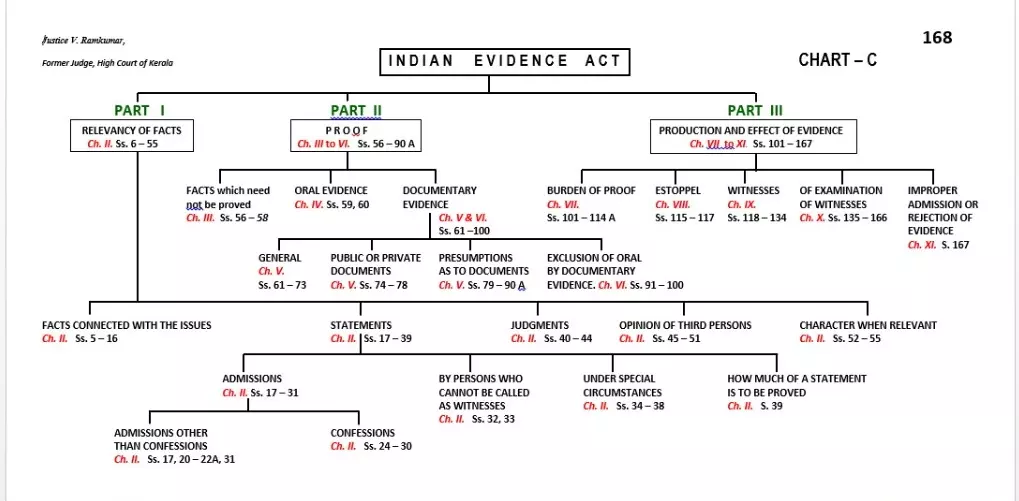
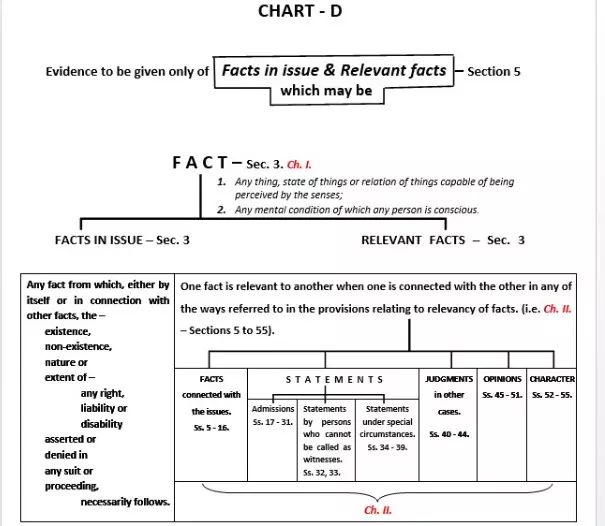
Q.123 What is the next step after the conclusion of the prosecution evidence ?
Ans. 313 Examination of the accused. In every trial, with a view to enable the accused to personally explain any of the incriminating circumstances appearing against him in the prosecution evidence, the Court has the power to question the accused both during and after the conclusion of the prosecution evidence. While the power of the Court to examine the accused at any stage during the trial, it is discretionary in view of Clause (a) of Section 313 (1) Cr.P.C., the power to examine the accused after the conclusion of the prosecution evidence under Clause (b) of Section 313 (1) Cr.P.C. is mandatory. In a summons case where the Court had dispensed with the personal attendance of the accused, the proviso to Section 313 (1) Cr.P.C. states that the Court may also dispense with the examination of the accused under Section 313 (1) (b) Cr.P.C.
Now after the insertion of sub-section (5) to Sec. 313 Cr.P.C, the Court can take the help of the prosecutor and the defence counsel in preparing the relevant questions and the Court can permit written answers by the accused. This will enable the Court to liberally exercise the power under Sec. 205 Cr.P.C. except in cases where the accused raises the defence of identity.
The ordinary rule is that no incriminating circumstance which has not been put to the accused, can be used against him for convicting him. (See Sharad Birdhichand Sarda v. State of Maharashtra - AIR 1984 SC 1622 - Fazal Ali, Varadarajan, Sabyasachi Mukharji - JJ; Lallu Manjhi v. State of Jharkhand - (2003) 2 SCC 401) = AIR 2003 SC 854 – R. C. Lahoti, Brijesh Kumar - JJ.)
Q.124 Which is the intermediate stage in a Sessions trial which is not there in a warrant trial ?
Ans. (In Sessions trial, there is an intermediate stage under Section 232 Cr.P.C. If, after the conclusion of the prosecution evidence it is noticed that there is absolutely no oral or documentary evidence supporting the prosecution, the Sessions Judge is given the power to terminate the proceedings at that stage without crossing over to the subsequent stages. The Judge can record an order of acquittal at this stage because no useful purpose will be served by anymore keeping the sword of Democles hanging over the head of the accused who is facing a charge for grave offence punishable with stringent punishment.)
Q. 125 Is there any obligation on the part of the Court in the matter of defence evidence in Warrant and Sessions trials ?
Ans. Yes. Defence Evidence, if any, can be adduced. In warrant trial instituted both on a “police report” and otherwise than on a police report. In a warrant case, Sections 243 and 247 Cr.P.C respectively oblige the Magistrate to call upon the accused to enter on his defense. Likewise, in sessions trial, Section 233 Cr.P.C obliges the Sessions Judge to call upon the accused to enter on his defense. Such a privilege of being called upon to enter on his defence is not available to the accused in summons or summary trial. The defense evidence is to be adduced as per Sections 243 (2) and 247 Cr.P.C in warrant trial and as per Section 233(3) Cr.P.C in sessions trial. Under Section 233(2) Cr.P.C the accused can also put in a written statement.
In a Sessions trial, it is only when the Sessions Judge does not record an order of acquittal under Section 232 Cr.P.C. that the Judge can under Section 233(1) Cr.P.C call upon the accused to enter on his defence. It is only after calling upon the accused to enter on his defense, should the Magistrate in a warrant trial and the Sessions Judge in a sessions trial, ask the accused whether he has any defence evidence. The practice of asking the accused soon after the close of 313 examination as to whether he has any defence evidence or not, is improper.
After the defence evidence, if any, has been adduced, the case will be taken up for arguments. The Prosecution represented by the Public Prosecutor has to first address the Court. Then it is the defense lawyer who will argue in reply.
Soon after the conclusion of arguments, the case will be taken up for Judgment. The Court can either pronounce judgment in open Court then and there or can reserve it for consideration and then pronounce the verdict on a date to be notified. The Judgment can be one of acquittal in a case where the prosecution has not been able to prove the guilt of the accused beyond reasonable doubt. Where the prosecution has succeeded in proving the guilt of the accused beyond reasonable doubt, the Court may record a conviction, finding the accused guilty of all or any of the offences with which he has been charged. In warrant trial the relevant provision is Section 248 (1) and (2) Cr.P.C. In sessions trial it is Section 235(1) Cr.P.C. Judgment should be in conformity with the requirements of Sections 353 and 354 Cr.P.C.
In case the accused is/ are convicted and if it is a fit case where the accused could be dealt with under the provisions of the Probation of Offenders Act, 1958, then appropriate orders have to be passed. Instead of sentencing the accused to any punishment at once to any punishment, the Court may pass an order either releasing the accused on probation or admonishing the accused. In those States or parts thereof, where the provisions of the Probation of Offenders Act, 1958 have not been extended, the accused will have to be dealt with under Section 360 Cr.P.C.
Where the accused is not dealt with under the provisions of the Probation of Offenders Act, 1958, the Court, before passing the sentence on the accused will have to hear the accused on the proposed sentence in a warrant and sessions trial.
In warrant trial and sessions trial, after recording the conviction and before passing the sentence, the accused is to be heard on the question of the proposed sentence under Sections 248 (2) and 235 (2) Cr.P.C., unless the Court decides to invoke the benevolent provisions of the Probation of Offenders Act, 1958. Where the conviction is for murder and the punishment imposed was only imprisonment for life, the Apex Court has held that failure to hear the accused under Section 235 (2) Cr.P.C. on the question of sentence, will not vitiate the trial. (Vide Tarlok Singh v. State of Punjab (1977) 3 SCC 218 = AIR 1977 SC 1747 – Krishna Iyer-J; Para 33 of Ramdeo Chauhan @ Raj Nath v. State of Assam (2001) 5 SCC 714 = AIR 2001 SC 2231 – 3 Judges – K. T. Thomas, R. P. Sethi, S. N. Phukan - JJ). This is because, for the conviction under Section 302 IPC either death penalty or, in the alternative, imprisonment for life are the only two options available to the Session Judge. Hence, if out of the two options the lesser penalty is sought to be imposed, failure to hear the accused on the proposed sentence was held to be not a grave infraction of law.
In a case where the minimum sentence had been awarded, it was held that failure to give opportunity on the question of sentence was merely academic and there was no need to remit the case to the trial Court for reconsideration on the question of sentence. (Vide Nirpal Singh v. State of Haryana (1977) 2 SCC 131 = AIR 1977 SC 1066 – P. N. Bhagwati, S. Murtaza Fazl Ali – JJ.)
In a case where the accused was convicted by the Supreme Court, under Section 392 IPC for the first time after reversing the judgments of the trial court and the High Court, the case was directed to be put up after 10 days for compliance with Section 235 (2) Cr.P.C. (Vide Suryamoorthy v. Govindaswamy (1989) 3 SCC 24 = AIR 1989 SC 1410 – S. Natarajan, A. M. Ahmadi – JJ.)
The Court has to impose a proper sentence which is commensurate with the gravity of the offence.
There is a great discretion vested in the Judge when pluralistic factors enter his sentencing calculation. Courts should personalize the sentence passed from a reformative angle. (Vide Mohammed Giyasuddin v. State of A. P. (1977) 3 SCC 287 = AIR 1977 SC 1926 – V. R. Krishna Iyer, Jaswant Singh – JJ.)
In a case where a 19 year old student belonging to a middle class family was sentenced to 2 years’ imprisonment and fine of Rs.2,000 for theft of a scooter and to 6 months’ imprisonment and fine of Rs. 500 for car lifting with a direction to suffer the sentences concurrently, the Supreme Court, taking note of the fact that we had already undergone imprisonment for 6 months, and got married and having three children, the Supreme Court on the strength of his uncle guaranteeing his good behavior, directed his release but without interfering with the fine portion of the sentence. In the course of the Judgment the Apex Court observed as follows:-
“The Court has to consider the totality of factors bearing on the offence and the offender and fix a punishment which will promote effectively the punitive object of the law, namely deterrence and habilitation.”……. “A long period of incarceration in the present condition of prisons may brutalize the boy and blunt his finer sensibilities so that the end – product may perhaps be more criminal than the one at the point of entry. Not that all prison terms are not deterrent but some cases prove to be counter-productive especially when the delinquent is young. The initial few months of jail life are the most painful and, therefore, the most deterrent.”……. “A long protracted litigation is also some deterrent for a young man in his twenties. The youthful age of the accused is a factor which deserves consideration. The offender having served a term of nearly 6 months must well have realised that the game of crime does not pay. Moreover, the young man has married and has three children. This is a measure of assurance that he will not play recklessly with his freedom. Family life is ordinarily an insurance against a career of crime.” (Vide Ashok Kumar v. State (Delhi Admn.) (1980) 2 SCC 282 = AIR 1980 SC 636 – V. R. Krishna Iyer, R. S. Pathak – JJ.)
The various trials under the Cr.P.C. can be depicted in the form of the following two charts for easy comprehension:-
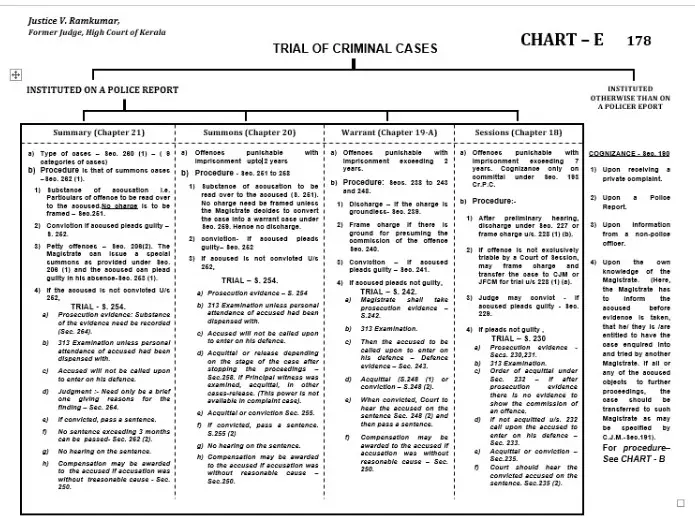
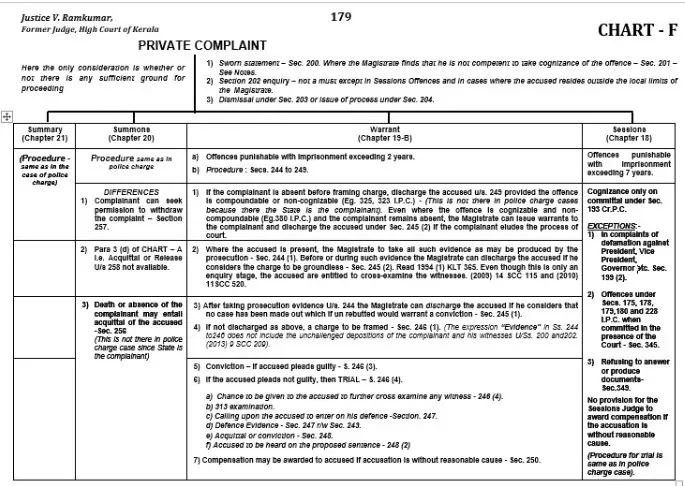
Part 23: Questions & Answers By Justice V. Ramkumar- Investigation By Police- PART XXIII
Part 21: Questions & Answers By Justice V. Ramkumar- Investigation By Police- PART XXI
Part 20: Questions & Answers By Justice V. Ramkumar- Investigation By Police- PART XX
Part 19: Questions & Answers By Justice V. Ramkumar- Investigation By Police- PART XIX
Part 18: Questions & Answers By Justice V. Ramkumar- Investigation By Police- PART XVIII
Part 17: Questions & Answers By Justice V. Ramkumar- Investigation By Police- PART XVII
Part 16: Questions & Answers By Justice V. Ramkumar- Investigation By Police- PART XVI
Part 15: Questions & Answers By Justice V. Ramkumar- Investigation By Police- PART XV
Part 14: Questions & Answers By Justice V. Ramkumar- Investigation By Police- PART XIV
Part 13: Questions & Answers By Justice V. Ramkumar- Investigation By Police- PART XIII
Part 12: Questions & Answers By Justice V. Ramkumar- Investigation By Police-PART XII
Part 11: Questions & Answers By Justice V. Ramkumar- Investigation By Police-PART XI
Part 10: Questions & Answers By Justice V. Ramkumar- Investigation By Police-PART X
Part 9: Questions & Answers By Justice V. Ramkumar- Investigation By Police-PART IX
Part 8: Questions & Answers By Justice V. Ramkumar- Investigation By Police-PART VIII
Part 7: Questions & Answers By Justice V. Ramkumar- Investigation By Police-PART VII
Part 6: Questions & Answers By Justice V. Ramkumar- Investigation By Police-PART VI
Part 5: Questions And Answers By Justice V. Ramkumar- Investigation By Police-PART V
Part 4: Questions And Answers By Justice V. Ramkumar(4) -Investigation By Police-PART IV
Part 3: Questions And Answers By Justice V. Ramkumar- Investigation By Police-PART III
Part 2: Questions And Answers By Justice V. Ramkumar- Investigation By Police-PART II
Part 1: Questions And Answers By Justice V. Ramkumar- Investigation By Police-PART I

